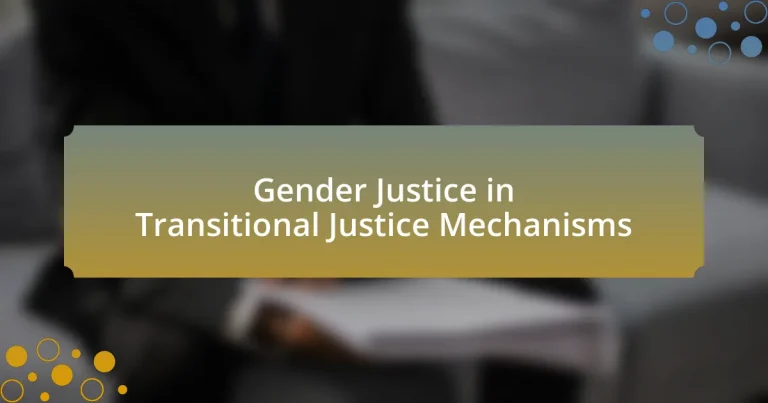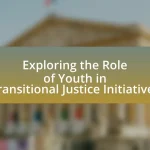Gender justice in transitional justice mechanisms refers to the equitable treatment of gender-specific issues and experiences in addressing past human rights violations, particularly focusing on the distinct impacts of conflict on women and marginalized groups. The article outlines the definition of gender justice within transitional justice frameworks, emphasizing principles such as equality, participation, and accountability. It discusses the importance of integrating gender perspectives to achieve comprehensive reconciliation and sustainable peace, while also addressing the challenges and barriers to implementing gender-sensitive approaches. Additionally, the article highlights successful case studies and best practices for promoting gender justice, underscoring the role of women’s organizations and the necessity of inclusive policies in transitional justice processes.
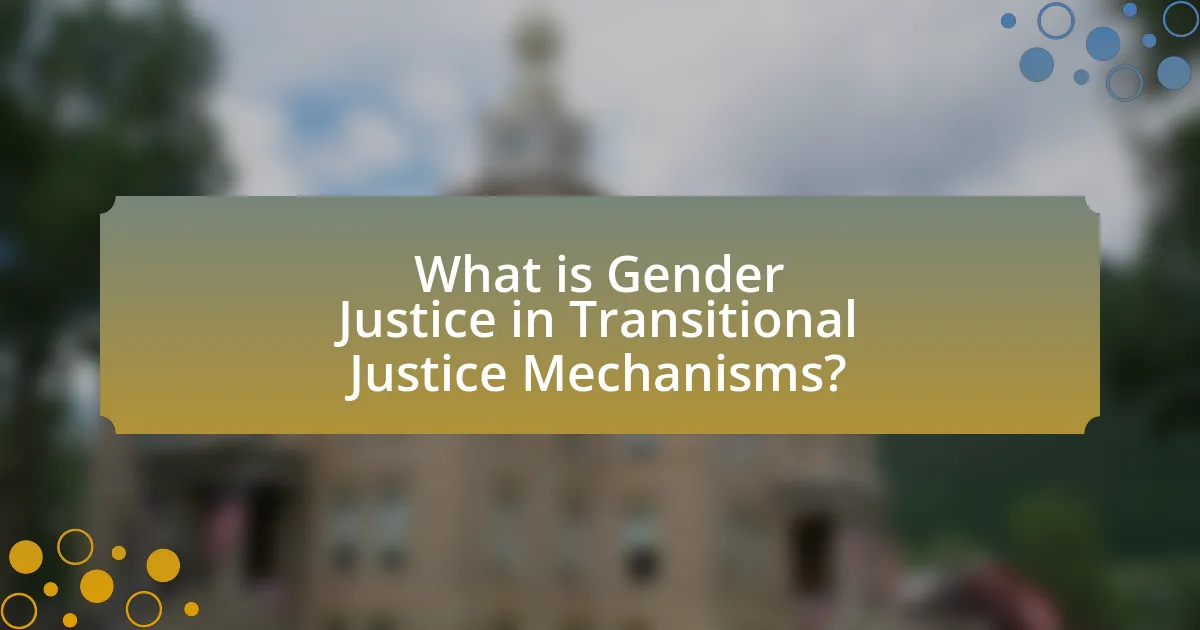
What is Gender Justice in Transitional Justice Mechanisms?
Gender justice in transitional justice mechanisms refers to the equitable treatment and consideration of gender-specific issues and experiences in processes aimed at addressing past human rights violations. This concept emphasizes the need to recognize and rectify the distinct impacts of conflict and systemic violence on different genders, particularly women and marginalized groups. Evidence from various transitional justice frameworks, such as the United Nations Security Council Resolution 1325, highlights the importance of including women’s voices and perspectives in peacebuilding and justice processes to ensure comprehensive and effective outcomes.
How is gender justice defined within transitional justice frameworks?
Gender justice within transitional justice frameworks is defined as the equitable recognition and addressing of gender-specific harms and injustices experienced during conflicts or authoritarian regimes. This definition emphasizes the need for transitional justice mechanisms to incorporate gender perspectives, ensuring that women’s experiences and voices are included in processes such as truth commissions, reparations, and legal accountability. Research indicates that gender justice is crucial for achieving comprehensive reconciliation and sustainable peace, as highlighted in the UN Security Council Resolution 1325, which calls for the inclusion of women in peace and security processes.
What are the key principles of gender justice in this context?
The key principles of gender justice in the context of transitional justice mechanisms include equality, participation, and accountability. Equality ensures that all genders have equal rights and access to justice, addressing historical injustices faced by marginalized groups. Participation emphasizes the need for inclusive processes that allow diverse voices, particularly those of women and gender minorities, to influence decision-making. Accountability involves holding perpetrators of gender-based violence accountable, ensuring that justice mechanisms address these crimes effectively. These principles are supported by international frameworks such as the United Nations Security Council Resolution 1325, which highlights the importance of women’s involvement in peace and security processes.
How does gender justice differ from traditional justice concepts?
Gender justice differs from traditional justice concepts by prioritizing the specific needs and experiences of marginalized genders, particularly women, in the pursuit of fairness and equality. Traditional justice often focuses on a one-size-fits-all approach that may overlook systemic inequalities and gender-based violence. For instance, gender justice recognizes that women face unique challenges in legal systems, such as underreporting of sexual violence and biases in judicial processes, which are not adequately addressed by conventional justice frameworks. This differentiation is supported by research indicating that gender-sensitive approaches in transitional justice can lead to more effective outcomes in addressing historical injustices and promoting social healing, as highlighted in the UN Women report on “Gender and Transitional Justice.”
Why is gender justice important in transitional justice processes?
Gender justice is crucial in transitional justice processes because it ensures that the specific experiences and needs of all genders, particularly women and marginalized groups, are recognized and addressed. This inclusion is essential for achieving comprehensive accountability and healing in post-conflict societies. Research indicates that when gender perspectives are integrated into transitional justice mechanisms, such as truth commissions and reparations programs, it leads to more effective outcomes and fosters societal reconciliation. For instance, the United Nations Security Council Resolution 1325 emphasizes the importance of women’s participation in peace and security processes, highlighting that gender-inclusive approaches contribute to sustainable peace.
What impact does gender justice have on post-conflict societies?
Gender justice significantly enhances the rebuilding process in post-conflict societies by promoting equality and addressing the specific needs of marginalized groups, particularly women. Implementing gender justice leads to more inclusive governance, which has been shown to improve social cohesion and stability. For instance, research by the United Nations indicates that countries with higher levels of gender equality in post-conflict reconstruction experience a 20% increase in peace sustainability. Furthermore, gender justice initiatives help to combat gender-based violence, which is often exacerbated in conflict situations, thereby fostering a safer environment for all citizens. This multifaceted impact underscores the necessity of integrating gender justice into transitional justice mechanisms to ensure comprehensive recovery and lasting peace.
How does gender justice contribute to sustainable peace and reconciliation?
Gender justice contributes to sustainable peace and reconciliation by ensuring equal participation and representation of all genders in peace processes, which fosters inclusivity and addresses the root causes of conflict. Research indicates that when women are involved in peace negotiations, the resulting agreements are 35% more likely to last at least 15 years, as shown in the study “Women, Peace, and Security: The Role of Women in Peace Processes” by the United Nations. This involvement not only enhances the legitimacy of peace agreements but also leads to more comprehensive solutions that consider the needs of diverse populations, thereby promoting long-term stability and social cohesion.
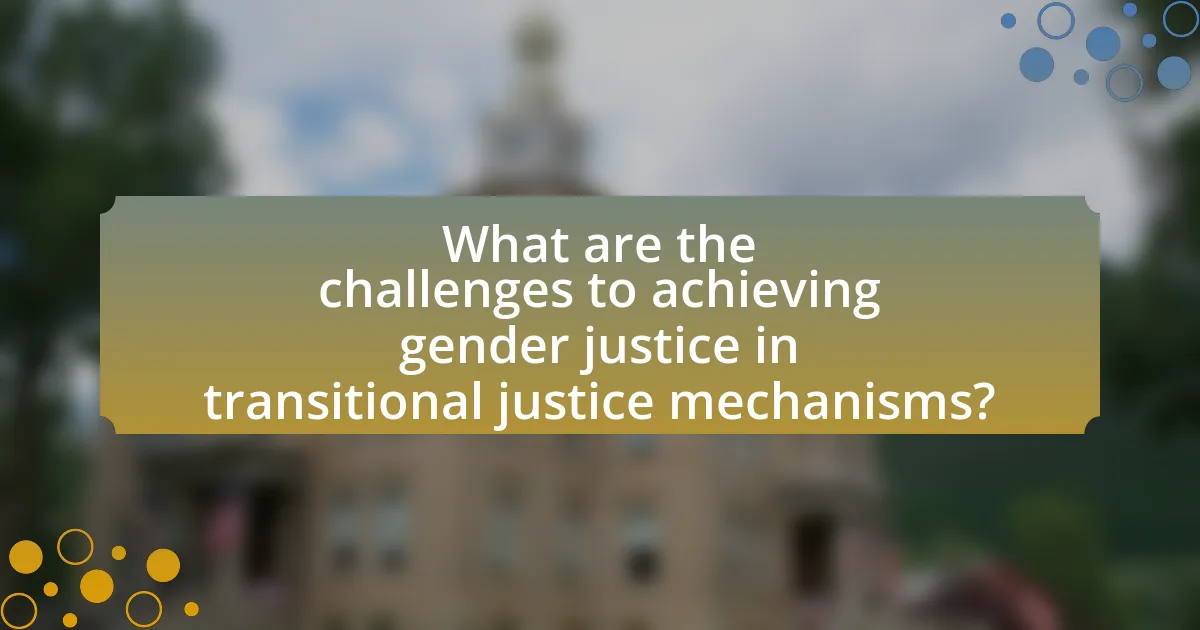
What are the challenges to achieving gender justice in transitional justice mechanisms?
Achieving gender justice in transitional justice mechanisms faces several significant challenges, including systemic gender biases, lack of representation, and inadequate legal frameworks. Systemic gender biases often result in the marginalization of women’s experiences and needs during transitional processes, leading to a failure to address gender-specific violence and discrimination. Furthermore, the underrepresentation of women in decision-making roles within transitional justice bodies limits the incorporation of gender perspectives in policy and practice. Inadequate legal frameworks also hinder the enforcement of gender justice, as many existing laws do not adequately address the complexities of gender-based violence or provide sufficient protections for victims. These challenges are evidenced by reports from organizations such as the United Nations, which highlight the persistent gaps in gender-sensitive approaches within transitional justice initiatives globally.
What barriers exist in implementing gender-sensitive approaches?
Barriers in implementing gender-sensitive approaches include entrenched societal norms, lack of political will, insufficient funding, and inadequate training for practitioners. Societal norms often perpetuate gender stereotypes, hindering the acceptance of gender-sensitive policies. Political will is crucial; without commitment from leadership, initiatives may lack necessary support. Funding is often limited, restricting the scope and effectiveness of gender-sensitive programs. Additionally, practitioners may not receive adequate training on gender issues, leading to ineffective implementation. These barriers collectively impede progress toward gender justice in transitional justice mechanisms.
How do cultural norms affect the pursuit of gender justice?
Cultural norms significantly influence the pursuit of gender justice by shaping societal attitudes and behaviors towards gender roles and equality. These norms can either facilitate or hinder the implementation of gender justice initiatives, as they dictate what is considered acceptable or taboo within a community. For instance, in societies where patriarchal norms dominate, women may face systemic barriers to accessing justice, such as discrimination in legal systems or social stigmas that discourage reporting gender-based violence. Research indicates that in many cultures, traditional beliefs about gender roles can lead to the marginalization of women’s voices in transitional justice processes, ultimately affecting the effectiveness of these mechanisms in addressing gender-based injustices.
What role do political structures play in hindering gender justice?
Political structures significantly hinder gender justice by perpetuating systemic inequalities and reinforcing patriarchal norms. These structures often prioritize the interests of dominant groups, marginalizing women’s voices and needs in policy-making processes. For instance, legislative bodies frequently lack gender representation, which results in laws that do not address or protect women’s rights effectively. According to the United Nations, only 25% of national parliamentarians were women as of 2021, illustrating the underrepresentation that limits gender-sensitive legislation. Additionally, political institutions may resist reforms aimed at promoting gender equality due to entrenched cultural attitudes, thereby obstructing progress toward gender justice.
How can these challenges be addressed effectively?
To address the challenges of gender justice in transitional justice mechanisms effectively, it is essential to integrate gender perspectives into all stages of the transitional justice process. This integration ensures that the unique experiences and needs of women and marginalized genders are recognized and addressed. For instance, the United Nations Security Council Resolution 1325 emphasizes the importance of women’s participation in peace processes, which has been shown to lead to more sustainable peace outcomes. Furthermore, implementing gender-sensitive training for justice officials and ensuring that legal frameworks explicitly include protections against gender-based violence can enhance accountability and support for victims. Studies indicate that countries with gender-responsive transitional justice mechanisms report higher levels of trust in institutions and improved social cohesion.
What strategies have proven successful in promoting gender justice?
Successful strategies for promoting gender justice include implementing gender-sensitive policies, ensuring women’s participation in decision-making processes, and integrating gender perspectives into transitional justice mechanisms. Gender-sensitive policies, such as those that address specific needs of women and marginalized groups, have been shown to improve outcomes in post-conflict settings. For instance, the United Nations Security Council Resolution 1325 emphasizes the importance of women’s involvement in peace and security processes, leading to more equitable outcomes. Additionally, the establishment of gender-specific reparations programs has been effective in acknowledging and addressing the unique harms faced by women during conflicts, as evidenced by case studies in countries like Rwanda and Liberia. These strategies collectively contribute to a more inclusive and just transitional justice framework.
How can stakeholders collaborate to enhance gender justice outcomes?
Stakeholders can collaborate to enhance gender justice outcomes by forming multi-sector partnerships that integrate diverse perspectives and resources. These partnerships can include government agencies, non-governmental organizations, community groups, and international bodies, all working together to create comprehensive policies and programs that address gender-specific injustices. For instance, the United Nations has emphasized the importance of inclusive dialogue in transitional justice processes, which can lead to more equitable outcomes for marginalized genders. Research shows that when stakeholders engage in collaborative frameworks, such as the Women, Peace, and Security agenda, they can effectively address systemic barriers and promote accountability for gender-based violence, thereby improving overall justice outcomes.
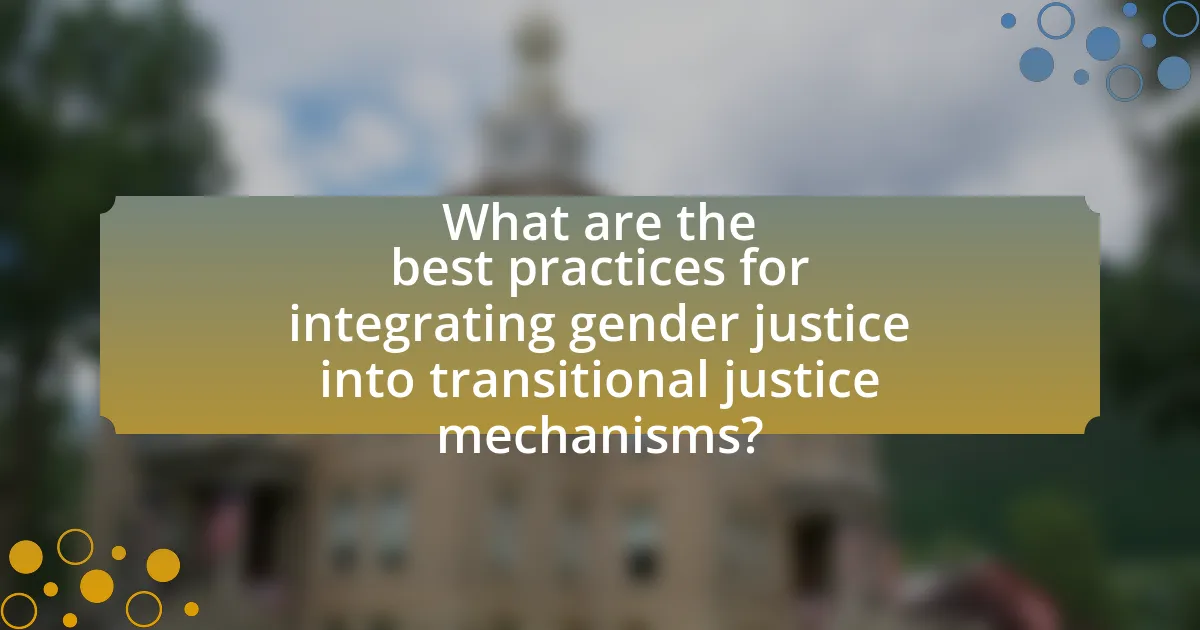
What are the best practices for integrating gender justice into transitional justice mechanisms?
The best practices for integrating gender justice into transitional justice mechanisms include ensuring women’s participation in all stages of the process, addressing gender-specific violations, and implementing gender-sensitive policies. Women’s participation is crucial as it leads to more inclusive and representative outcomes; for instance, studies show that when women are involved in peace negotiations, the resulting agreements are 35% more likely to last at least 15 years. Addressing gender-specific violations, such as sexual violence, is essential to acknowledge the unique experiences of women and ensure accountability; the United Nations Security Council Resolution 1325 emphasizes the importance of addressing these issues in transitional justice. Lastly, implementing gender-sensitive policies, such as training for justice officials on gender issues, can enhance the effectiveness of transitional justice mechanisms and promote gender equality.
What frameworks exist for incorporating gender perspectives?
Several frameworks exist for incorporating gender perspectives, including the Women, Peace and Security Agenda, the Convention on the Elimination of All Forms of Discrimination Against Women (CEDAW), and the Gender Equality Framework of the United Nations. The Women, Peace and Security Agenda, established by United Nations Security Council Resolution 1325, emphasizes the importance of women’s participation in peace processes and decision-making. CEDAW provides a comprehensive framework for addressing gender discrimination and promoting women’s rights globally. The UN Gender Equality Framework outlines strategies for integrating gender considerations into all aspects of development and humanitarian efforts. These frameworks are supported by various international treaties and resolutions that advocate for gender equality and the protection of women’s rights in transitional justice contexts.
How can gender analysis be applied in transitional justice processes?
Gender analysis can be applied in transitional justice processes by systematically examining how gender dynamics influence experiences of conflict and justice. This approach ensures that the specific needs and perspectives of different genders are recognized and addressed, leading to more equitable outcomes. For instance, research shows that women often face unique forms of violence during conflicts, such as sexual violence, which necessitates tailored responses in justice mechanisms. By incorporating gender analysis, transitional justice can enhance accountability, promote healing, and foster inclusive participation in post-conflict societies, ultimately contributing to sustainable peace.
What role do women’s organizations play in these frameworks?
Women’s organizations play a crucial role in gender justice within transitional justice mechanisms by advocating for the inclusion of women’s perspectives and experiences in policy-making processes. These organizations mobilize grassroots support, raise awareness about gender-based violence, and ensure that women’s rights are prioritized in post-conflict reconstruction efforts. For instance, the United Nations Security Council Resolution 1325 emphasizes the importance of women’s participation in peace and security processes, highlighting the impact of women’s organizations in promoting gender equality and justice. Their involvement leads to more comprehensive and effective transitional justice frameworks that address the specific needs of women affected by conflict.
What lessons can be learned from successful case studies?
Successful case studies in gender justice within transitional justice mechanisms demonstrate the importance of inclusive participation, tailored approaches, and the integration of gender perspectives. These case studies reveal that involving women and marginalized groups in decision-making processes leads to more equitable outcomes, as seen in the post-conflict reconstruction efforts in Rwanda, where women’s representation in governance significantly improved social cohesion and justice. Additionally, the effectiveness of gender-sensitive policies, such as those implemented in South Africa’s Truth and Reconciliation Commission, highlights the necessity of addressing specific gender-based violence and discrimination to achieve comprehensive justice. These examples underscore that successful transitional justice mechanisms must prioritize gender equity to foster lasting peace and reconciliation.
Which countries have effectively implemented gender justice in their transitional justice mechanisms?
Countries that have effectively implemented gender justice in their transitional justice mechanisms include Rwanda, South Africa, and Colombia. Rwanda’s post-genocide recovery process integrated gender considerations into its legal framework, leading to significant representation of women in decision-making roles and the establishment of gender-sensitive legal processes. South Africa’s Truth and Reconciliation Commission addressed gender-based violence during apartheid, acknowledging women’s experiences and incorporating them into its findings. Colombia’s peace agreement with the FARC included specific provisions for women’s rights and participation, ensuring that gender justice is a fundamental aspect of the transitional justice process. These examples demonstrate a commitment to integrating gender justice within transitional justice frameworks.
What specific outcomes were achieved in these successful cases?
Successful cases in gender justice within transitional justice mechanisms achieved specific outcomes such as increased representation of women in decision-making processes, legal reforms addressing gender-based violence, and the establishment of reparations programs tailored to women’s needs. For instance, in post-conflict societies like Rwanda, women occupied 61% of parliamentary seats following the genocide, significantly influencing legislation and policy. Additionally, the Truth and Reconciliation Commission in South Africa recognized gender-based violence as a critical issue, leading to formal acknowledgment and reparations for victims. These outcomes demonstrate the effectiveness of integrating gender perspectives into transitional justice frameworks, resulting in more equitable and inclusive societies.
What practical steps can be taken to promote gender justice in transitional justice mechanisms?
To promote gender justice in transitional justice mechanisms, it is essential to integrate gender perspectives into all stages of the process. This includes ensuring women’s participation in decision-making bodies, which has been shown to lead to more comprehensive and inclusive outcomes. For instance, the United Nations Security Council Resolution 1325 emphasizes the importance of women’s involvement in peace and security processes, highlighting that their participation can enhance the effectiveness of transitional justice initiatives. Additionally, implementing gender-sensitive training for personnel involved in transitional justice can help address biases and improve the understanding of gender-related issues. Furthermore, establishing mechanisms for documenting and addressing gender-based violence during conflicts is crucial, as evidenced by the International Criminal Court’s focus on prosecuting sexual violence as a war crime. These steps collectively contribute to a more equitable and just transitional justice framework.
How can policymakers ensure gender considerations are prioritized?
Policymakers can ensure gender considerations are prioritized by integrating gender analysis into all stages of policy development and implementation. This approach mandates that gender perspectives are systematically included in assessments, consultations, and evaluations, thereby addressing the specific needs and experiences of different genders. For instance, the United Nations Security Council Resolution 1325 emphasizes the importance of women’s participation in peace and security processes, highlighting that inclusive policies lead to more effective outcomes. By adopting frameworks like this, policymakers can create mechanisms that not only recognize but actively promote gender equity in transitional justice initiatives.
What resources are available for advocates of gender justice?
Advocates of gender justice can access various resources, including legal frameworks, academic research, and support networks. Legal frameworks such as the Convention on the Elimination of All Forms of Discrimination Against Women (CEDAW) provide guidelines for promoting gender equality. Academic research, including studies published by organizations like UN Women and the International Justice Resource Center, offers evidence-based insights into gender justice issues. Additionally, support networks such as the Global Fund for Women and local NGOs provide funding, training, and advocacy tools to empower gender justice advocates. These resources collectively enhance the capacity of advocates to address gender-related injustices effectively.
